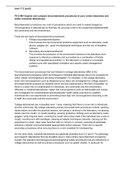Unit 17 C and D
P5 & M4- Explain and compare biocontainment procedures in your centre laboratory and
within industrial laboratories.
Biocontainment procedures are a set of precautions which are used to isolate dangerous
microorganisms in laboratories so that they do not pose a risk to the researchers/students/staff,
the community and the environment.
There are two types of biocontainment procedures.
1. Primary biocontainment/barrier;
This involves the use of personal protective equipment such as laboratory coats,
gloves, goggles etc., good microbiological techniques and the use of biosafety
cabinets.
2. Secondary biocontainment/barrier;
This involves the protection of the environment external to the laboratory from
exposure to infectious materials and is provided by a combination of facility
design and operational practices I.e. the laboratory is located in a complete
isolated zone with specialised ventilation and specific waste management
systems.
The biocontainment procedures that are followed in college laboratories differ to the
biocontainment procedures which are followed in industrial laboratories due to the purposes for
which certain microorganisms are being investigated. For example, in the college laboratory,
lower risk microorganisms such as Staphylococcus albus are investigated for college research
and experimental purposes by students whom are less experienced in the field of biosafety, so
there is a lower risk of contamination to individuals, the community and the environment.
Whereas in industrial laboratories, higher risk microorganisms such as Salmonella and viruses
are investigated for industrial/pharmaceutical/public health safety purposes by qualified
individuals who are experienced at preventing these high risk microorganisms becoming a risk
to staff, the community and the environment.
College laboratories are a biosafety level 1 area, meaning that there is a low risk to individuals
and the community. My college laboratory primary biocontainment procedures include; washing
hands before and after the practical session, not eating or drinking in the laboratory, not placing
hands near the mouth, no mouth pipetting, wearing protective clothing such as laboratory coats,
goggles, tying long hair back, covering the mouth with a face mask if the individual has a cold or
cough, covering cuts with bandages, obeying all aseptic techniques correctly, carrying out the
experiment on clear, clean open benches with no corners or crevices, ensuring all potentially
infectious material is decontaminated appropriately before disposal. There are no specific
secondary procedures other ensuring there is a sink available for handwashing.
On the other hand, industrial laboratories are generally biosafety level 2,3 and 4. For pathology
and research laboratories that are biosafety level 2, their primary biocontainment procedures
include; the standard microbiological practices/general safety procedures that are followed by in
college laboratories as well as primary procedures such as splash shields, in particular for





